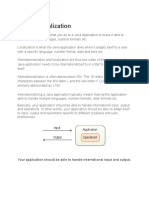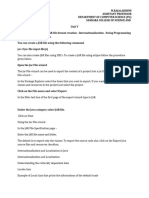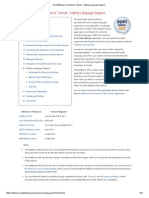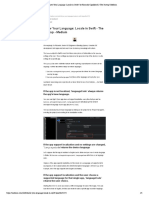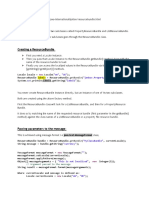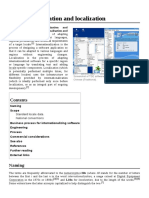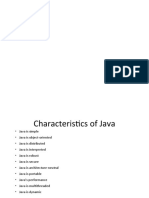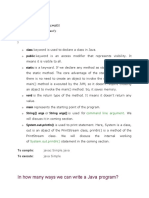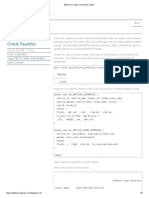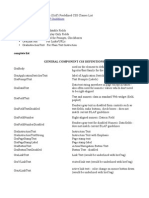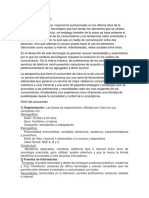9/11/2017 Java Internationalization - javatpoint
Internationalization and Localization
in Java
Internationalization is also abbreviated as I18N because there are
total 18 characters between the first letter 'I' and the last letter 'N'.
Internationalization is a mechanism to create such an application that
can be adapted to different languages and regions.
Internationalization is one of the powerful concept of java if you are
developing an application and want to display messages, currencies,
date, time etc. according to the specific region or language.
Localization is also abbreviated as I10N because there are total 10
characters between the first letter 'L' and last letter 'N'. Localization is
the mechanism to create such an application that can be adapted to a
specific language and region by adding locale-specific text and
component.
Do You Know ?
What is the use of Locale class ?
How can we globalize the messages (or) What is the use of
ResourceBundle class?
How can we internationalize the date, time, number, currency and
measurements?
Understanding the culturally dependent
data before starting internationalization
Before starting the internationalization, Let's first understand what are
the informations that differ from one region to another. There is the list
of culturally dependent data:
https://www.javatpoint.com/internationalization-in-java 1/6
�9/11/2017 Java Internationalization - javatpoint
Messages
Dates
Times
Numbers
Currencies
Measurements
Phone Numbers
Postal Addresses
Labels on GUI components etc.
Importance of Locale class in
Internationalization
An object of Locale class represents a geographical or cultural region.
This object can be used to get the locale specific information such as
country name, language, variant etc.
Fields of Locale class
There are fields of Locale class:
1. public static final Locale ENGLISH
2. public static final Locale FRENCH
3. public static final Locale GERMAN
4. public static final Locale ITALIAN
5. public static final Locale JAPANESE
6. public static final Locale KOREAN
7. public static final Locale CHINESE
8. public static final Locale SIMPLIFIED_CHINESE
9. public static final Locale TRADITIONAL_CHINESE
10. public static final Locale FRANCE
11. public static final Locale GERMANY
12. public static final Locale ITALY
13. public static final Locale JAPAN
14. public static final Locale KOREA
15. public static final Locale CHINA
16. public static final Locale PRC
https://www.javatpoint.com/internationalization-in-java 2/6
�9/11/2017 Java Internationalization - javatpoint
17. public static final Locale TAIWAN
18. public static final Locale UK
19. public static final Locale US
20. public static final Locale CANADA
21. public static final Locale CANADA_FRENCH
22. public static final Locale ROOT
Constructors of Locale class
There are three constructors of Locale class.They are as follows:
1. Locale(String language)
2. Locale(String language, String country)
3. Locale(String language, String country, String variant)
Commonly used methods of Locale class
There are given commonly used methods of Locale class.
1. public static Locale getDefault() it returns the instance of
current Locale
2. public static Locale[] getAvailableLocales() it returns an array
of available locales.
3. public String getDisplayCountry() it returns the country name
of this locale object.
4. public String getDisplayLanguage() it returns the language
name of this locale object.
5. public String getDisplayVariant() it returns the variant code for
this locale object.
6. public String getISO3Country() it returns the three letter
abbreviation for the current locale's country.
7. public String getISO3Language() it returns the three letter
abbreviation for the current locale's language.
Example of Local class that prints the
informations of the default locale
https://www.javatpoint.com/internationalization-in-java 3/6
�9/11/2017 Java Internationalization - javatpoint
In this example, we are displaying the informations of the default locale.
If you want to get the informations about any specific locale, comment
the first line statement and uncomment the second line statement in the
main method.
1. import java.util.*;
2. public class LocaleExample {
3. public static void main(String[] args) {
4. Locale locale=Locale.getDefault();
5. //Locale locale=new Locale("fr","fr");//for the specific locale
6.
7. System.out.println(locale.getDisplayCountry());
8. System.out.println(locale.getDisplayLanguage());
9. System.out.println(locale.getDisplayName());
10. System.out.println(locale.getISO3Country());
11. System.out.println(locale.getISO3Language());
12. System.out.println(locale.getLanguage());
13. System.out.println(locale.getCountry());
14.
15. }
16. }
download this example
Output:United States
English
English (United States)
USA
eng
en
US
Example of Local class that prints english in
different languages
In this example, we are displaying english language in different
language. Let's see how english is written in french and spanish
languages.
https://www.javatpoint.com/internationalization-in-java 4/6
�9/11/2017 Java Internationalization - javatpoint
1. import java.util.*;
2. public class LocaleExample2 {
3. public static void main(String[] args) {
4. Locale enLocale = new Locale("en", "US");
5. Locale frLocale = new Locale("fr", "FR");
6. Locale esLocale = new Locale("es", "ES");
7. System.out.println("English language name (default): " +
8. enLocale.getDisplayLanguage());
9.
10. System.out.println("English language name in French: " +
11. enLocale.getDisplayLanguage(frLocale));
12. System.out.println("English language name in spanish: " +
13. enLocale.getDisplayLanguage(esLocale));
14. }
15.
16. }
<strong>Output:
</strong>English
language name
Example of Local class that print display
language of many locales
In this example, we are displaying the display lanuage of many locales.
1. import java.util.*;
2. public class LocaleEx {
3. public static void main(String[] args) {
4. Locale[] locales = { new Locale("en", "US"),
5. new Locale("es", "ES"), new Locale("it", "IT") };
6.
7. for (int i=0; i< locales.length; i++) {
8. String displayLanguage = locales[i].getDisplayLanguage(locales[i]);
9. System.out.println(locales[i].toString() + ": " + displayLanguage);
10. }
11. }
12.
https://www.javatpoint.com/internationalization-in-java 5/6
�9/11/2017 Java Internationalization - javatpoint
13. }
Output:en_US: English
es_ES: espa?ol
it_IT: italiano
What we will learn in Internationalization Tutorial ?
ResourceBundle class
I18N with Date
I18N with Time
I18N with Number
I18N with Currency
I18N with Measurements
<<prev next>>
Please Share
Latest 4 Tutorials
DB2 MariaDB
ADO.NET ASP.NET
https://www.javatpoint.com/internationalization-in-java 6/6


